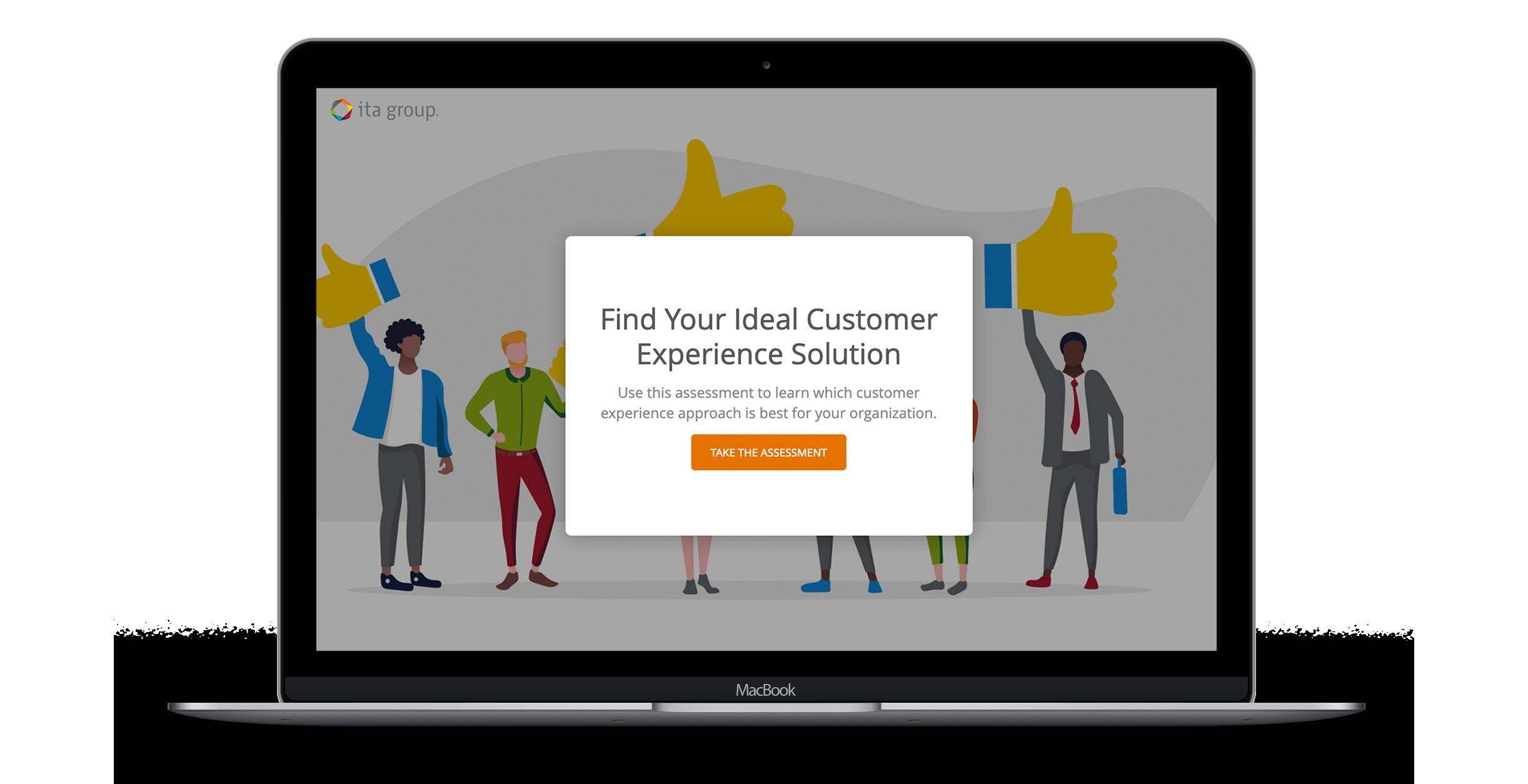




During lockdown periods the past few years, Gartner found that brands committed as much as 80% of their marketing spend on digital. Customers shopped and worked from home, limiting the avenues to reach them.
Now, we’re seeing a need and a desire by organizations to readjust their marketing mix to go beyond only digital. Brands have a big opportunity to grab customers’ attention with unexpected, personalized experiences that center on connecting with their customers.
In most cases, this connection is built through excellent customer service and high-quality products. Brands that do it well have turned their interactions, or their product, into part of the holistic customer experience.
Even among competitive brands that produce comparable goods or services, customers have varied expectations and relationships with each one. The organizations that pair unexpected value with their brand promise create a unique opportunity to win over customers, new and old. Here’s a real-world example. ITA Group worked with a mortgage lender that experienced historic numbers of refinances and couldn’t process the mortgages promptly. To save their customer relationships—and strengthen them—we personalized a customer service experience no one saw coming. The communication campaign recognized the service gap, reinforced customers’ value by thanking them for their patience and sent them a gift for their trouble.
In this case, a package of Omaha Steaks with a sincere message of “dinner on us.” The solution was a hit, reinforcing the brand with almost 100,000 homeowners. It also garnered positive earned media for our client with a blurb in the Financial Times.
These customer relationship trends led us to reimagine our solutions for how customers connect with brands on an emotional level.
Our Breakthrough Touchpoint solution helps organizations pinpoint specific moments that matter in the customer journey, which leads to more positive outcomes. It also shows how going beyond digital marketing can meet customers’ demands for personalized, memorable and meaningful interactions.
According to the Zendesk Customer Experience Trends Report 2020, around 80% of customers are willing to leave a brand after a lackluster performance. That means organizations must play the long game—where each new interaction with customers is the most important yet.

At ITA Group, we help inspire emotional connection for our brands, and create equity in the customer's minds, boosting the brand's odds of increasing customer lifetime value.
Max Kenkel ITA Group Solution Line Leader, Customer Solutions

 By: Sarah Borchers, Customer Solutions Insights & Strategy Leader
By: Sarah Borchers, Customer Solutions Insights & Strategy Leader
Marketers need to deliver relevant, personalized customer experiences to compete with the many products and brands on the market. But personalizing the experience in the correct way can be tricky.
Done right, personalization contextualizes the customer experience in a way that boosts value to customers. It often involves combining first-party data, marketing expertise and your insider knowledge about your unique audiences. To personalize the experience, marketers need to take what data they have and use it to make informed decisions about how to increase customer value across all touchpoints in the customer life cycle.
And yet, increasing concerns about privacy have disrupted the use of first-party data and launched new opportunities for marketers to use zero-party data (data that is voluntarily given) to not only boost value but make the customer experience more tailored, relevant and better overall.
Zero-party data is the gold standard of data because it’s straight from the source (so it’s extra reliable) and can be used to make the personalized experiences customers crave.
Because zero-party is shared directly, its trustworthy and unambiguous information that can be used for segmentation, personalization engines and product recommendation tools.
ZERO-PARTY
Direct data voluntarily given by customer to brand in exchange for something valuable
FIRST-PARTY
Direct data gathered by brand based on customer’s past interactions with them
Until recently, the primary form of data that marketers used to personalize the customer journey was third-party data. Third-party data is data acquired from a data aggregator. Data aggregators don’t collect data directly, but rather obtain it from other companies and compile it into a single dataset.
The problem with third-party data is it comes from unrelated and unreliable sources, such as cookies and click trails.
THIRD-PARTY
Indirect data collected by data aggregator and compiled into a single data set
As a result, it quickly becomes outdated and has no direct relationship with the individual customer. Using this sort of data to power campaigns has been the key driver is growing customer mistrust.
While third-party data is still used (and many marketers aren’t ready to pivot away from that model), its days are numbered.
Google is set to phase out third-party cookies beginning in 2024. Many other popular internet browsers, like Safari, have been blocking them for years. Major publishers, including The New York Times, are transitioning away from third-party advertising data. And Privacy Sandbox, a series of initiatives that began in 2019, is creating new standards for privacy online with safer alternatives to existing datagathering technology. More and more customers are concerned about protecting their data and their privacy from digital trackers, installing ad blockers and changing privacy settings to deny them access.
In fact, a recent survey found 66% of consumers find targeted advertisements generated from cookie tracking to be creepy instead of cool.
We call this the “era of privacy,” and it’s made it increasingly difficult for marketers to build and maintain trusted relationships with customers, who feel like marketers are tracking and taking advantage of them without permission.
However, within this challenge is an opportunity for marketers to switch to zero-party data, which lacks the negative connotations and provides more accurate insights into customers’ behaviors. Because zero-party data requires consent, it’s automatically compliant with privacy regulations as well. It’s a win-win.
Forrester defines zero-party data as data a customer intentionally and proactively shares with a brand, often in exchange for something they view as valuable. The exchanged item could be something like a personalized recommendation, a price reduction, a prize drawing entry, etc.
Because the item is perceived as valuable, customers will voluntarily give up a bit of information about themselves.
In a survey by Accenture, 91% of customers said they will shop with brands that provide relevant offers and recommendations.
Zero-party data can help you discover what’s relevant to your customer and use that relevant offer to procure additional zero-party data. Each offer is an opportunity to learn more about your customers and their needs. There are many benefits for the brand in this exchange, too. It helps the customer build trust in the brand. Because it’s directly from the customer, you don’t have to guess what the data means.
For example, is this customer buying baby clothes because she’s pregnant or because she’s going to a baby shower? Algorithms might not be able to tell. Zero-party data can give you the full picture. Everyone gets what they want.
For zero-party data to be useful, it needs to be connected to a first-party customer profile. This means brands need to collect the data digitally after customers identify themselves through registering or logging in to a customer-experience platform.
The first step to winning over skeptical customers who are hesitant to hand over data is to keep them entertained and engaged through interactive digital experiences.
They need to feel they are receiving something worthwhile for their attention and, eventually, their personal data.
Marketers can even speed up the process of collecting zero-party data by incorporating incentives (such as instant wins, gamification and giveaways).
When asking customers for zero-party data, keep these three key principles in mind:
1. Be transparent. Explain why you are collecting the data and how you intend to use it.
2. Don’t force things. Ask just for what data you need, and let them share as they are ready.
3. Deliver a fair value exchange. Offer a meaningful exchange, and make sure what you’re offering feels equal to what they’ll get in return.
When done well, interactive experiences create an engaging process for collecting zero-party data, inviting customers to build trust in the brand and continue engaging throughout the customer life cycle.
ITA Group can help you be creative with how to gather zero-party data and use it to build lasting customer engagement.
For example, we helped one of our manufacturing clients learn about their customers' preferences by developing a sweepstake with a grand prize all-expensespaid trip to attend the Indy 500.
We crafted the sweepstake entry to include a few tailored questions that allowed our client to segment customers and target industry professionals who entered the sweepstakes. Within that professional audience, our client was able to further segment customers who were planning on attending an upcoming product expo.
Our solution allowed the client to organize a targeted marketing outreach to potential attendees found through the sweepstakes promotion—all while adhering to customer privacy laws. The buzzworthy nature of the grand prize garnered incredible media attention, prompting even more people to volunteer zero-party data in the hopes of winning the trip. In the end, there were 4,600 entries, 636 of which were industry professionals planning on going to the expo—they were immediately added to the communications cadence to help customize their experience. This allowed the client to cultivate warmer leads ahead of the expo.


CMB, a Top 30 Insights & Analytics company, and a wholly owned subsidiary of ITA Group, Inc., leverages the best of advanced analytics, consumer psychology, and market strategy to tackle game-changing initiatives. Read below to see how CMB's experts are translating insights into action in a meaningful and memorable way when it comes to data quality, brand health/positioning and subscriptions.
At CMB, we strive for the highest standards of research and data collection. But all of us are dealing with historically high rates of data fraud. While there are many ways of mitigating your data fraud risks, when you are looking to implement strategic projects that involve data, considering asking these questions to your trusted research partners to ensure that they’re doing all they can to combat data fraud, including:
1. In field reports, are you willing to share total completes and subsequent “actual” completes [how many were lost after quality check (QC) process?] Can I routinely see into the QC process and how many respondents are being removed and replaced?
2. Which third-party sample fraud tools are you aware of? Which ones are you investigating? Which ones are you using? Do you have agreements in place with specific sample vendors for this?
3. Do you have success stories to share that illustrate your ability to tackle fraudulent data?
Communicating openly about the percent of fraudulent respondents uncovered is akin to a badge of honor these days, and clients appreciate the honesty and transparency in our process.
Finding and removing imposters with everimproving tools can be achieved. In B2B research, this is even more necessary because much higher incentives attract much more sophisticated “incentive-harvesting” operations. For tough audiences in Tech, B2B “panels” are often abandoned and instead rely exclusively on Expert Networks and other specialty recruiters to ensure data quality.
Kudos to all those implementing third-party tools. Speaking from experience, it’s tough onboarding these data tools. If sample providers and third-party vendors do not have existing agreements in place, it can wreak havoc on study launches. There are plenty of moving parts on a questionnaire script with invites, redirects, and quotas. When additional third-party programming is implemented, there are new potential points of error with the up-front data fraud screening. On a recent study where we had multiple tools implemented with one third-party vendor, three individual tools in the programming were not working with the redirects.
In cases like this, if programmers and vendors are not properly aligned, they may substantially delay a study launch.
Having multiple QC measures in place to prevent fraudsters from making it to your survey is a lofty but attainable goal. While it may not sound like success, revealing that 50% of the respondents were proactively prevented from taking the questionnaire with third-party tools and another 10% of completes failed internal QC and needed replacement is an example of success when you know you’ve improved data quality to an extent that could have altered the key findings of a study.
So, what are the best pieces of armor for protection? It’s most likely that the more layers of protection implemented, the better.
Are your partners using a three-pronged approach at minimum?

1. A strong, smart questionnaire containing red herrings and other internal QC pieces
2. Third-party sample fraud tools as appropriate
3. Internal, proprietary QC protocols to ensure the best data quality for your research
Let’s abandon the old trope of “garbage in, garbage out.” How about high-quality respondents into the questionnaire, quality data out? Time to ask your vendors what they are doing to help combat data fraud. Transparency is key. And if your vendors are failing you, you can rely on your partners at CMB to do what’s right.
Leslie Rich, Ph.D AVP, Tech & Telecom Account ManagementTrackers have been a core component of brand research for decades. They provide important KPIs that help brands evaluate how they perform with consumers and the impact of their campaigns and other market actions. In a nutshell, trackers help explain past performance to the business.

Amid the present climate, a 3-year pandemic from which we are still emerging, the Great Reshuffling that has consumers rethinking their priorities, and ever-changing consumer journeys, CMB believes trackers need to look forward and work harder to not only explain the past, but to guide your business’s next bets, actions and re-actions to a rapidly transforming market.
CMB’s Brand Health Audit & Action program fuses behavioral psychology with best-in-class analytics to construct a program that is purposefit to your objectives. The dedicated team works with you and your key stakeholders to craft a bespoke Audit & Action program. If you’re not starting from scratch, CMB will preserve the value of the KPIs in your current program while introducing new modules that identify forwardlooking actions to achieve your strategic goals.
CMB’s advanced analytics approach allows you identify drivers and model outcomes to determine where your next marketing dollar should be spent. Having a better understanding of your customer’s emotion journey is critical to your business. Leveraging behavioral psychology helps uncover that and provide you with a comprehensive emotion action plan. It also helps identify opportunities to re-engage customers who currently have negative emotions towards your brand, and tackle or prevent neutral emotions from hinder your acquisition efforts.
Understanding how consumers are interacting with your brand via our Connected Consumer module can uncover many ways for you to be proactive with your brand strategy. This has been an area of particular focus as consumer interactions rapidly changed and evolved in response to accelerated digitization triggered by the pandemic. Evaluating the multi-channel experience to better measure the effectiveness of target market messaging and in-channel performance will help you to confidently target media through mapping consumers’ brandengagement touchpoints and the impact they are having on marketplace perceptions .
You’ve leveraged both advanced analytics and identified how customers interact with your brand, and now it’s time to mobilize these insights and ignite action within your organization. With role-based dashboards, you can deliver the right insights to the right person in a context that better enables them to make informed decisions that drive the desired outcome. Additionally, you can take your insights further by designing custom, multi-media immersive experiences for your stakeholders that may include visuals, video, audio commentary, music, etc. These experiences are designed to bring your results to life and help your decision-makers internalize the insights and inform their decision-making.
Trackers will continue to be a core component of marketing strategies in tandem with market research. How you leverage your trackers will determine if your organization lags or propels forward. Don’t look back, move forward and strengthen your brand health and position for long-term success with CMB’s Brand Health Audit & Action program. Let’s continue the conversation, contact us today.
Richard Scionti VP, Product Development & Innovation

Subscriptions have become the norm. Beyond the expected streaming services, there are a range of products that are now available as subscriptions, including meal prep delivery, razor blades, and even jerky to name a few. Subscription services have really shifted from a novelty to a mature category. In fact, even Taco Bell is getting in on the action. As brands grow and evolve, here are a few thoughts to consider as they seek to enter in this space:
As some of these categories are getting increasingly crowded with competitors, brands need to move past the low hanging fruit categorybased benefits (e.g., convenience, savings) and find “white space” that is also competitively distinct. When cost savings is a category driver, there is a risk when competitors enter to have a “race to the bottom” with price cut after price cut…with service and quality then suffering…and everyone losing. Brands need to identify the elements of their value prop that are both compelling and competitively distinct.
For example, some brands in the subscription space distinguish themselves as “curators”— helping consumers wade through the overwhelming amount of alternatives to find the best choice for them.
What got people in the door (ex: cost savings) may not be a reason they stay. With an increasingly uncertain economy, and increasingly crowded competitive spaces, consumers face hard choices in their daily lives. Brands always need to be tweaking their offering(s) and its benefits to stay relevant. For example, in the beginning of the COVID-19 pandemic, Amex Platinum successfully shifted from travel-related to adjacent benefits like streaming service savings, Uber Eats credits, etc. This kind of attention to a consumer’s shifting needs keeps customers loyal and leads to greater advocacy, which further leads to acquisition.
In a consumer-centric world, brands are learning how to be easy to do business with. For example, I believe Netflix actually increases loyalty by, ironically, making it easier for its members to quit. Their service is made easier by not having an annual membership and making the cancellation process as simple as a couple of clicks. In fact, if they notice you haven’t used your account for 12 months, they automatically cancel it. That’s going above and beyond. I wish my gym would do that for me and put me out of my misery.
The dynamics of COVID-19 resulted in so many changes in consumer behaviors, and brands are investing so much in identifying which ones will stay as the time goes on (and if you aren’t, you should!). Our clients find that CMB’s Habit Loops framework helps bring the above elements all together to uncover opportunities to trigger routines that support their brand, disrupt habits that don’t, and help make their brand become a part of customers’ everyday lives: automatic and hard to disrupt.
The growth rates in subscription services over the last few years may not continue at this pace, but these services aren’t going away. Brands that leverage insights to help with the issues above will be in the best position for success…although, their success does nothing to help my already crowded monthly credit card statement (taco, anyone?).
Mark Doherty VP, Retail & eCommerce






In fact, 80% of customers say the experiences provided by a company are as important to them as its products and services. In other words, organizations that prioritize and measure customer engagement will see improved customer retention, loyalty and advocacy, setting themselves apart from the competition.

According to Dan Gingiss, author and customer experience expert, “Most companies must realize that they are no longer competing against the guy down the street or the brand that sells similar products. Instead, they're competing with every other experience a customer has.”
Customers want to feel the brand understands them on a personal level. And the personalization must happen from the point of first contact through product purchase, support, upgrade, renewal and any additional transaction phases. For example, here’s how Delta Airlines personalized the customer engagement experience for my colleague in a way that surprised and delighted them.
While on their first flight after the COVID-19 pandemic began, they posted on social media and tagged Delta Airlines saying, “so glad to be back.” Once they boarded the plane, the flight attendant welcomed them on board and said, “We’re glad you chose Delta for your first flight back!” The engagement didn’t stop there. When my colleague returned home, there was a handwritten note in their mailbox from the pilot who flew the plane that day. Wow! Now that’s pristine customer engagement.
The demand for customers’ attention is at an all-time high compared to the last few years. They have more power than ever to choose how and when to engage with a brand. Relying on a good product to grow brand loyalty isn’t good enough anymore to engage customers.
Moral of the story: Delta listened to the customer through an engagement platform and responded in a personalized way we typically haven’t seen in the past. My colleague said it best, “Delta will always be my first choice for any flight in the future.”
Talk about long-term brand loyalty.
Delta took the time to listen to my colleague— their customer—and provided a memorable experience. Implement the following three best practices so you also can create a personalized customer experience with your brand.
We all receive or see countless digital ads every day. Cut through the clutter by reaching customers at key moments along the customer journey with a surprise-and-delight engagement. We like to call those moments “breakthrough touchpoints.” The touchpoints can be used in a variety of ways, such as:
> Customer or subscriber onboarding
> Milestone or thank-you gifts
> Service or product recovery
> Stagnant loyalty
> Rebates
> Reactivation
Breakthrough touchpoints deliver unique customer experiences at any point in the customer journey. Going the extra step for personalization ensures customers hear your brand’s message and see the value you provide.
In the end, your brand stays top of mind, and you improve retention, generate loyalty and build affinity.
Customers decide when and how to interact with brands or whether to ignore a brand based primarily on how brands are positively contributing to society. Customers want to hear from brands beyond just products and services to form deeper connections.
When they’re more connected to brands, 57% of consumers will increase their spending with the brand and 76% will choose that brand over a competitor.
For example, footwear and apparel retailer TOMS believes in philanthropy and addressing issues that matter. The beliefs served as the foundation for a postcard-writing campaign advocating for gun reform on its website and social channels. Within the first year, TOMS estimates consumers sent 750,000+ postcards to state legislators.
Customers crave authenticity and real connections with brands. The key to effectively reaching them by taking a social stance is making sure the stance is authentic to your brand’s mission, purpose and core beliefs.
Increasing customer retention rates by just 5% can increase profits between 25–95%.
—BAIN & COMPANY
Do you have a loyalty program that needs some rejuvenation? Read how we helped a leading financial institution develop a creative recovery tactic.
info.itagroup.com/our-work-customer-journey
Organizations have access to data by surveying customers regularly and putting the feedback to use. Focus on metrics like what customers value and how they realize the value. Then use that data to understand what ensures customers stay and are willing to buy more. Unified reporting and analytics tools can measure customer engagement levels at every touchpoint.

Instead of just thanking customers for sharing feedback, show them how you’re using it! By evolving beyond basic demographic information and purchase history, you'll collect more zero-party data to make every customer experience personal, relevant and enjoyable, ensuring the brand and customers both win.
Customers expect more from brands than ever before. Personalizing their experience is no longer a nice to have—it’s a need to have. Continuing to engage with customers after the sale is critical to retaining customers and building brand advocacy. Happy customers drive deeper, more engaged and more profitable relationships over the long term.
 By: Karli Quesinberry, Customer Solutions Strategist
By: Karli Quesinberry, Customer Solutions Strategist
A successful rebate strategy takes focus. Done right, it can drive increased buyer interest, stronger consumer loyalty, higher revenue and greater profitability. But before we dive into some of the specifics of rebate strategy, let’s first define what we mean when we say rebate, look at when rebates are most effective and identify what parts of the consumer journey this approach can influence.
What is a rebate?
A rebate, also known as a premium with purchase, is an award offered at the time of purchase to incent a consumer to purchase your brand over another.

According to the Promotion Marketing Association, consumers are 75.4% more likely to buy your product if there is a rebate present.
Compare that with promotions like contests or sweepstakes, which only increase the likelihood to buy by 42.5% and by 39%, respectively. Rebates, where a consumer gets a free gift with purchase, have shown to increase their purchase likelihood as much as 82.8%.
When are rebates most effective for brands?
Instead of offering savings with a reduced price at point-of-sale, rebates ask shoppers to complete additional steps to get cash back.
As a sales tactic to drive primary purchases, rebates work best when the direct selling audience (often a sales rep at a store) can use the rebate as a selling tool.
While rebates entice shoppers to buy a particular product with the hope of getting cash back, many shoppers actually fail to complete the process. Rebates often succeed when they are perceived as easy (and valuable) enough in the consumer’s eyes to get them to purchase your brand, but not so great that they redeem.
What part of the buyer’s journey does the rebate impact?
While rebate programs can act as a touchpoint within each of the phases below, they have the most impact within the consideration and purchase phases.
This is when price is most likely to be a factor. If most other features are comparable, then a rebate can help negate price in the favor of your brand.
Adjusting any of the following considerations during a promotion will influence activation rates, consumer satisfaction, confidence and brand sentiment.
1. Advertising: How will consumers find out about the offer? How do you want them to find out? How are you prepping the direct sales team about the upcoming offer?
2. Rebate Value: The dollar or percent off of a product or service, or the perceived value of the award.
3. Strike Price: The final price of the product or service after the rebate.
4. Effort: How hard is it to redeem? Is the effort worth the award?
5. Consumer Confidence: The consumer’s belief they can submit it easily and will receive the payout without complications.
6. Utility Margin to Income: Individuals spend their incomes first on what they value most highly, regardless if it’s a fully conscious determination. This form of satisfaction is called “utility” and argues human beings seek to maximize their own utility.
Consider the following example, which helps bring these six ideas working together to life.
The consumer walks into a store. She is deciding between two products and sees that Brand A has a rebate offer (Advertising) for 20% off (Rebate Value). Quick math shows her the rebate will be for about $10, and she can submit her rebate on her phone (Effort).
The fine print states some might not get the rebate for up to 12 weeks (Consumer Confidence). But it’s a product she buys regularly, and she’s always wanted a reason to try this brand (Utility Margin to Income). She purchases the product and totally forgets about the rebate.
Even though it was easy, she either didn’t want to wait or couldn’t be bothered to remember to redeem it because it was too small of value. This results in a winning scenario for the brand. The offer enticed the consumer to buy and left the consumer’s award in their own hands.
Rebates have proven to be effective consumer promotions designed to generate long-term consumer loyalty and brand affiliation that drive product sales while providing savings to priceconscious shoppers.
The following best practices will help you get more out of your rebate.
> Establish clear goals and an effective method to measure success.
> Train the sales audience on how to leverage the rebate as a tool to help close the sale leading up to the rebate.
> Eliminate antiquated payment options to avoid ongoing negative exposure for your brand.
> Integrate survey questions into the rebate and leverage data collected for re-targeting efforts.
> If you have SPIFFs available for the direct sales audience, ensure there is alignment around the products funded and the products on rebate.
Customers shouldn’t need to go through multiple steps just to find out they are ineligible to receive the award for some unclear reason noted in the fine print. It’s all about finding the right balance.
Rebate design and the technology that supports it should work together to create an easy experience for the consumer.




